How To Use Email To Alienate Your Users
Spam! Monty Python may love it, but the rest of us are not so convinced. But what is spam? Are you spamming users without realizing it? And is there any place in the world for email marketing?
Most of us have a love/hate relationship with email. Its one of those necessary evils. Nowhere is our relationship with email more confused than when it comes to spam.
For a start, spam is hard to define. Google defines it as:
Sending the same message indiscriminately to (large numbers of recipients) on the Internet.
But what does that actually mean? The truth is, what one person considers acceptable, another could hate with a loathing.
Without a clear definition of acceptable and unacceptable behavior, it becomes easy for email marketing to alienate users, rather than win them over.
Should we, therefore, give up on email as a marketing tool entirely? Absolutely not.
The Benefits Of Email Marketing
Done right, email marketing can be a wonderful tool, not just for you but for your subscribers, too.
Email marketing does not all have to be about pushing readers into completing a call to action (although it is very effective at that). It is also about keeping your brand in their mind so that when they do need your services, they will think of you and not your competitors.
Email communication has the potential to be a great way to build a lasting relationship. It’s a chance for a more personal level of interaction than a website normally provides. You can ask questions, encourage discussion and gather feedback. Good email marketing is a dialogue rather than a monologue.
Good email marketing doesn’t just benefit the sender. It should also provide real benefit to the reader, too. It should help them solve problems, keep them informed and provide tangible value. After all, that is what they expected when they signed up.
The problem is that often subscribers do not make a conscious decision to sign up, and they don’t really want the emails in the first place.
“Why Am I Getting This Email?”
Notice that I am presuming that some level of consent has been given by subscribers. I hope you know better than to email people unsolicited.
That said, the term “unsolicited” can be interpreted in many ways, and you may have strayed into a gray area without even realizing it.
First, let me be clear: buying an email list gathered by a third party is, in my opinion (and I suspect the opinion of those on the list), unsolicited email. If you don’t want to alienate people, don’t go down this path.
Secondly, just because someone has signed up to your service doesn’t mean they have agreed to receive email from you.
This is an important distinction. As part of the sign-up process, you may have indicated that you will email them, or you may have even provided an option for them to opt out. However, if the user didn’t spot this, then you will still alienate them, despite being entirely within your rights. The email is still unsolicited in their eyes.
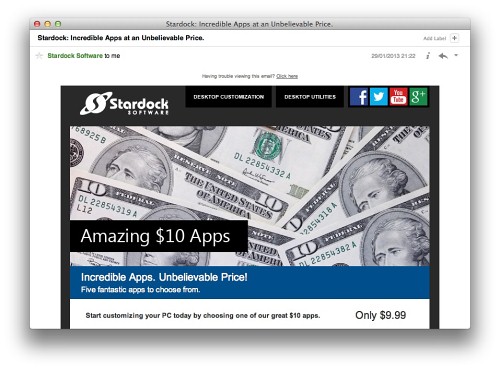
I have no memory of agreeing to an email subscription when I bought a Stardock app, but I still regularly receive email from the company.
Notifications, which have become increasingly popular, are another example of this gray area.
“I Don’t Want To Be Notified”
On the face of it, notification emails seem innocent enough. It makes sense that if a friend signs up for the same service as I have, I would want to know. Equally, if someone comments on something I have done, then being informed of that via email would be useful.
Unfortunately, these emails have increasingly had little to do with helping the user and everything to do with pushing them to re-engage.
When someone signs up for your website, service or app, remember that if you wish to send them notifications, then you need to make this transparent and allow them the opportunity to opt out.
How you handle the addition of notification emails at a later date is also important. Recently, Twitter started emailing people with a summary of their Twitter stream. I imagine Twitter thought this to be a useful tool that would encourage users to participate more. Instead, all it did was alienate them.
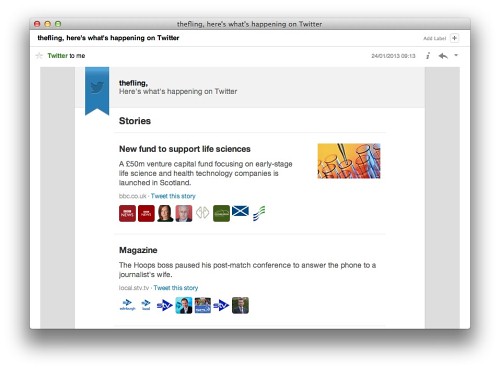
Twitter started sending out notification emails without specifically asking people to opt in. This alienated many users.
Many people had old Twitter accounts they no longer used and suddenly found themselves getting unsolicited email from Twitter. To make matters worse, unsubscribing proved to be extremely difficult.
“I Just Want To Unsubscribe”
Enabling users to unsubscribe from email updates should go without saying. Not offering this option means that users will mark your email as spam, and that could ultimately get your emails permanently banned.
However, just because an email has an unsubscribe option doesn’t mean it won’t alienate users. Take the Twitter example again. You had an option to unsubscribe from its emails but only once you had logged into the service. If you are receiving email notifications for a defunct account, chances are you cannot remember your log-in details.
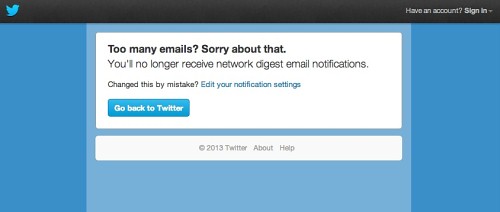
I would love to unsubscribe from Twitter’s notification digests, but I cannot because I don’t know my log-in details.
Unsubscribing should be as easy as clicking a link. Anything else, and you risk annoying the recipient even more.
Of course, what you really want is for users not to unsubscribe in the first place. A good way to avoid this problem is to stay on topic.
“This Isn’t What I Signed Up For”
When people do subscribe intentionally, they do so with certain expectations. Meeting those expectations is important if you do not wish to alienate them.
Keep a consistent tone across all of the digital channels through which you communicate. If your website strikes a formal, conservative tone, while your email is much more conversational, the contrast will unsettle users. The “story” and “character” need to be consistent. Social media, email and your website should all speak in a single voice and with a consistent message.
People have expectations not just about how you speak to them, but about what content you deliver.
For example, people who sign up for my newsletter expect the latest Web design-related news. That is what I told them they would get, and that is what I have to deliver. If I start pushing my Web design services instead, they are going to feel lied to, and I would alienate them.
Remember, it is rare that a user will subscribe to email updates purely to be sold to. They almost certainly have other expectations. Just receiving sales pitches holds little value to them.
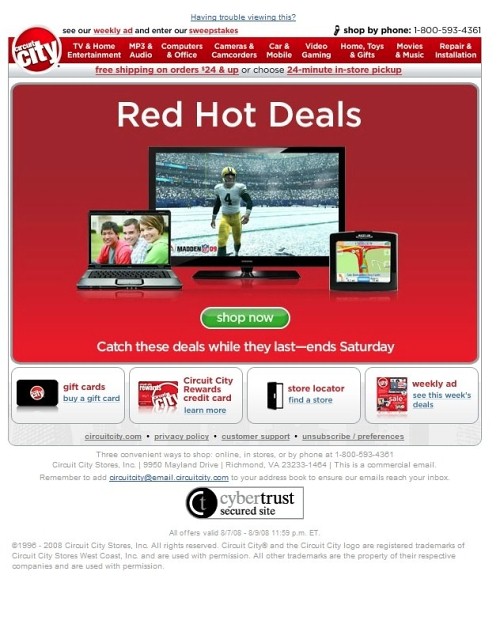
Users rarely want email subscriptions to be nothing more than endless sales pitches.
In many ways, a subscription to your mailing list is a contract. The user entrusts you with their personal contact details, in return for something of value. They will tolerate some degree of departure from that topic to hear your sales message, but it is easy to take things too far.
What they will not tolerate is continually being pressured into following the same call to action.
Even if a user has signed up to, say, a charity newsletter, that newsletter should consist of more than constant appeals for donations. The emails also need to share success stories, educate the audience and provide some sense of value.

The RSPCA animal charity’s newsletter is a good mixture of appeals and informational content.
Providing value is so important not only because it will keep the audience engaged, but because it shows you are putting the subscriber’s needs ahead of your own.
“You Obviously Don’t Care About Me”
Too many mailing-list owners are so busy pushing their agenda and maximizing click-throughs and conversions that they show little interest in subscribers.
Their emails are read for what they are, mass broadcasts. I work long and hard to make the emails I send out each week sound personal, as if I were writing to just one person.
To keep our subscribers, we need to treat them as people and not as open rates or click-through statistics.
This can manifest itself in two ways. First, our emails need to avoid marketing jargon and instead read like any other personal email. The writing style of your average marketing email is fascinating; you would never write like that if you were writing to just one person.

Marketing copy and poor personalization really can make a subscriber feel completely unappreciated.
Secondly, email is supposed to be a two-way medium, and we need to treat our marketing emails in that way. This means allowing users to reply, and not sending emails from addresses like no-reply@company-name.com.
We should be actively seeking to engage our subscribers in discussion. We should ask their opinion, encourage comments and post the occasional poll. By doing so, we demonstrate that they are more than an email address to us.
This, of course, all depends on whether they can read our email in the first place.
“This Is Impossible To Read”
In their enthusiasm to increase email conversion rates, many mailing-list owners resort to ever more elaborate email designs. Unfortunately, this all too often leads to unreadable emails that send recipients instantly to the “Unsubscribe” (or, worse, the “Spam”) button.
Unlike many Web designers, I see nothing wrong with HTML email. It does statistically generate a higher conversion rate, and that cannot be ignored. However, HTML emails do take work to get right, and they need to be tested thoroughly.
To make matters more complicated, it is now vital to consider mobile devices. A huge percentage of users now access their email on mobile devices, and the email clients on these devices don’t display HTML email particularly well.
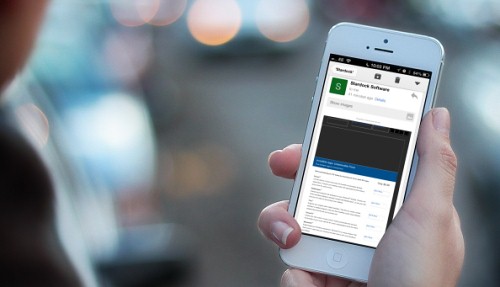
Too many HTML emails are not tested on mobile devices and, consequently, are unreadable.
Fortunately, you can make HTML email responsive, and companies such as MailChimp even provide tools to do so with no programming knowledge required.
Of course, if all else fails, a plain-text version should be available to those subscribers who want it.
“I Just Want Some Respect”
Ultimately, the secret to not alienating subscribers is simple: treat them with respect.
You can’t go far wrong if you follow the old adage, “Treat others as you would have them treat you.” If you hate being signed up for stuff without your permission, being constantly sold to, and not being able to easily unsubscribe, then others likely feel the same way about your content.
No matter how important you feel your emails are, they are probably like any others to your subscribers.
Further Reading
- Design And Build Email Newsletters Without Losing Your Mind
- An Introduction To Building And Sending HTML Email
- Typographic Patterns In HTML Email Newsletter Design
- Email Marketing For Mobile App Creators


 Devs love Storyblok - Learn why!
Devs love Storyblok - Learn why!

 Register For Free
Register For Free JavaScript Form Builder — Create JSON-driven forms without coding.
JavaScript Form Builder — Create JSON-driven forms without coding. Get a Free Trial
Get a Free Trial How To Measure UX and Design Impact, 8h video + UX training
How To Measure UX and Design Impact, 8h video + UX training

